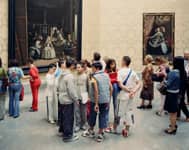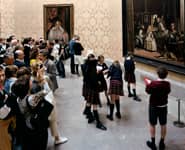He initially tried to make works the way he had envisioned it during his first visit to the Prado. However “after the Audience series, I felt I could not go back to photographing the backs of people standing in front of a painting. I thought I should go into the middle of a room, place myself in the middle of the crowd, and crop the painting so the figures in the painting and in the room could be brought even closer together.” He made several works in the room with Las Meninas as well as individual works of people with Velázquez’s Las Hilanderas and The Surrender of Breda.
In the series of photographs made in the Las Meninas gallery, Struth places equal emphasis on the paintings and the crowds of viewers. The technical system necessary to light the audience as well as the paintings was complicated, requiring a lighting system consisting of some fifteen flash heads installed in the ceilings of a number of rooms.
In 2007, eight of Struth’s earlier museum pictures as well as six from the new Prado series were shown at the Prado in an exhibition entitled Making Time. The Museum Photographs works were placed in a direct dialogue with specific paintings from the collection of the Prado. For example, Struth’s photographs of a crowd in a museum in Tokyo looking at Delacroix’s Liberty Leading the People was installed opposite Goya’s painting The Third of May 1808. Struth’s self-portrait looking at Dürer’s self-portrait from the Alte Pinakothek in Munich was hung on the same wall as an earlier Dürer self-portrait from the collection of the Prado. Six of the pictures Struth had made in the Prado were also exhibited.
For the opening of the new wing of the Prado by Rafael Moneo, Struth exhibited three different friezes of Audience pictures in the new spaces: from the Accademia in Florence, the Hermitage in St. Petersburg and the Prado itself.


